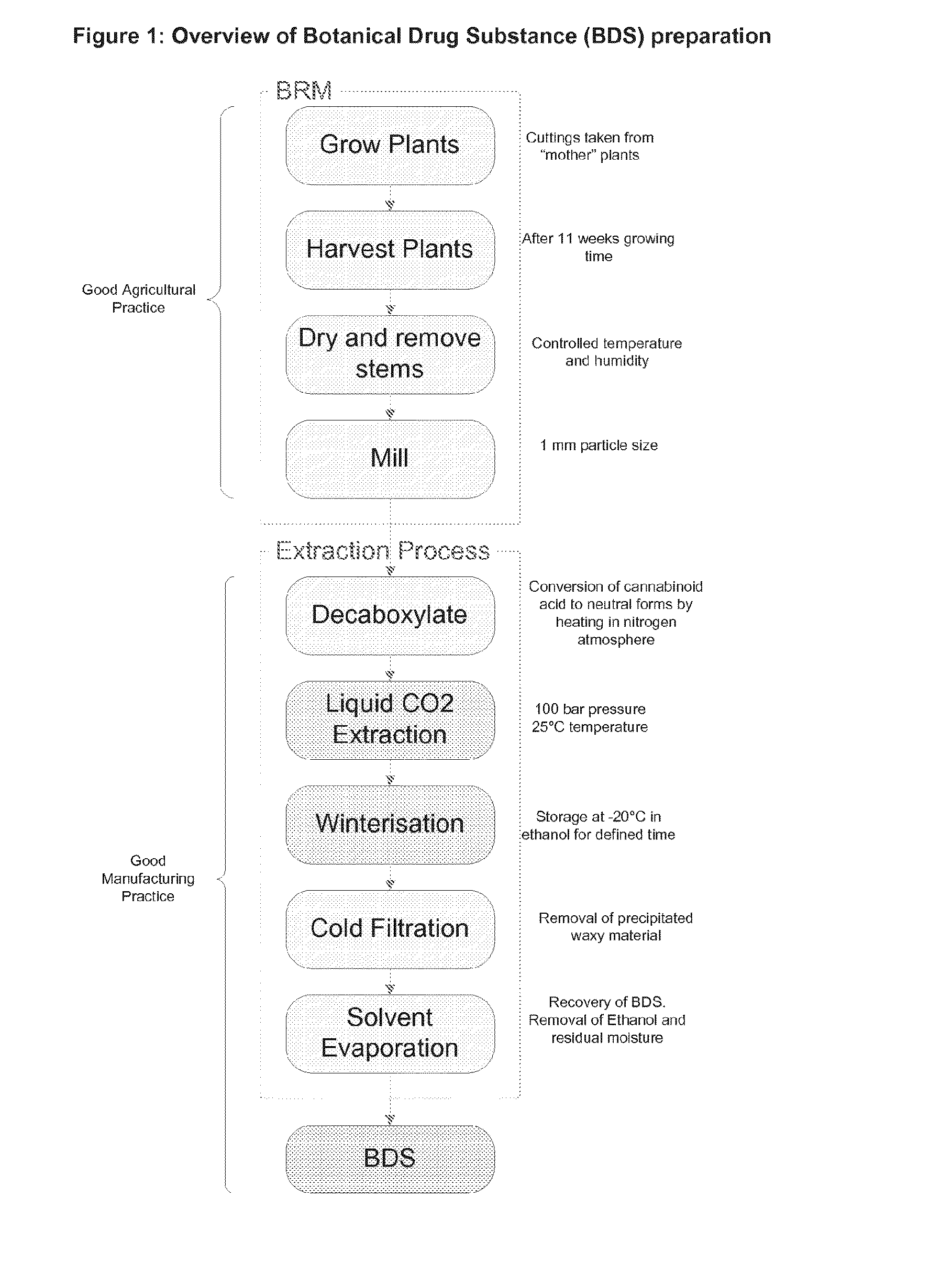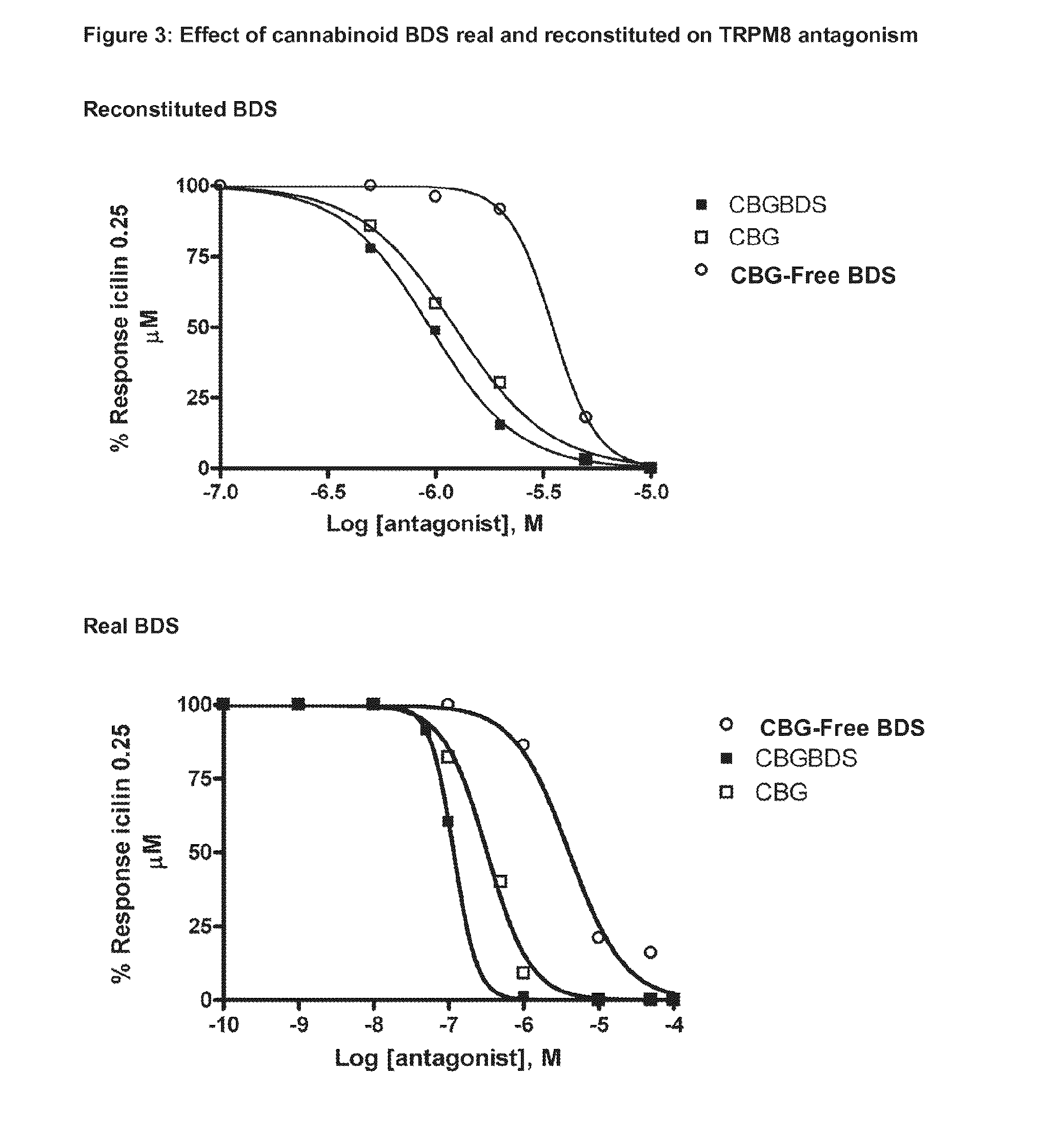Phytocannabinoids in the treatment of cancer
a technology of phytocannabinoids and cancer, applied in the field of phytocannabinoids in the treatment of cancer, can solve the problems of cancer growth that cannot be controlled by hormone treatment, stop responding, and cannot be true, and achieve the effect of slowing down growth and reducing the volume of prostate cancer tumours
- Summary
- Abstract
- Description
- Claims
- Application Information
AI Technical Summary
Benefits of technology
Problems solved by technology
Method used
Image
Examples
example 1
Botanical Production and Manufacture of Cannabinoid BDS
[0128]Botanical Raw Material (BRM) is obtained from varieties of Cannabis sativa L. (chemotypes) which have been developed to specifically produce high levels of a given phytocannabinoid as the principal phytocannabinoid. The cannabinoid CBG is the precursor molecule in the biosynthetic pathway to THC, CBD and CBC. Other cannabinoids are then formed from these cannabinoids. The principal cannabinoid produced in the plant will be present as the carboxylic acid form in the plant material, as are any of the other secondary or minor cannabinoids. The carboxylic acid form of the cannabinoid is usually decarboxylated to the neutral form during processing of the BRM to Botanical Drug Substance (BDS).
[0129]The plants used to prepare the cannabinoid BDS can either be wild type plants or plants specifically bred to produce one cannabinoid as a principle cannabinoid. These plants are referred to as ‘chemotypes’. For example the paper by (D...
example 2
Phytocannabinoid and Non-Cannabinoid Components in BDS
[0133]The following example illustrates the different phytocannabinoid components that make up each of the BDS's described. In each table the principle phytocannabinoid is defined in bold typeface.
[0134]The BDS's were extracted using liquid CO2 and then a high performance liquid chromatography (HPLC) method was used to analyse the different cannabinoid components in each cannabinoid BDS.
[0135]The tables detailed below describe average amounts of the principle, secondary and minor phytocannabinoids in each representative BDS. The skilled person will appreciate that as the BDS's are extracted from cannabis plants they will of course be subject to a degree of variation in their composition. Generally the amounts by which each of the phytocannabinoid components will vary by will be in the range of ±10% (w / w). However depending on the starting plant material and the method of extraction used these amounts may vary by as little as ±5% ...
example 3
Effect of Phytocannabinoids on Apoptosis in Hormone-Insensitive Prostate Cancer Cell Line (DU-145) and Hormone-Sensitive Prostate Cancer Cell Line (LNCaP)
[0168]The effect of CBDV BDS, CBD BDS, THCVA BDS, THCV BDS, isolated THCV and isolated THCVA on the apoptosis of two prostate cancer cell lines were tested using a chemioluminescence assay for caspase 3 / 7 release. Two different concentrations of cannabinoids were tested; a low dose (10 μM) and a high dose (25 μM). The chemioluminescence that were recorded for each phytocannabinoid are detailed in FIG. 2.
[0169]In the hormone-insensitive prostate cancer cell line (DU-145) the highest chemioluminescence and as such the highest pro-apoptotic effects were found with the low dose CBDV BDS and the high dose isolated THCVA purified cannabinoid at 25 μM. The high dose THCV BDS, CBD BDS and isolated THCV also showed apotosis levels over that of the control.
[0170]In the hormone-sensitive prostate cancer cell line (LNCaP) the highest chemiolum...
PUM
 Login to View More
Login to View More Abstract
Description
Claims
Application Information
 Login to View More
Login to View More - R&D
- Intellectual Property
- Life Sciences
- Materials
- Tech Scout
- Unparalleled Data Quality
- Higher Quality Content
- 60% Fewer Hallucinations
Browse by: Latest US Patents, China's latest patents, Technical Efficacy Thesaurus, Application Domain, Technology Topic, Popular Technical Reports.
© 2025 PatSnap. All rights reserved.Legal|Privacy policy|Modern Slavery Act Transparency Statement|Sitemap|About US| Contact US: help@patsnap.com



